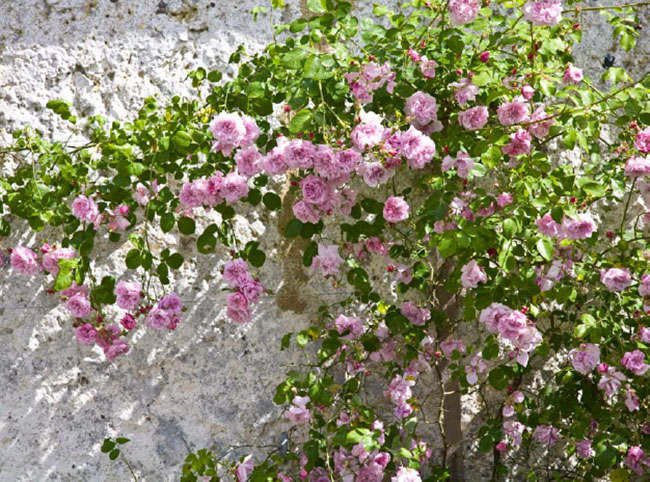
Catherine Thomas enjoys the romance and versatility of the rose, exploring what this beloved bloom can do for your garden.
We love our roses, and with good reason: there are our native species (such as Shakespeare’s eglantine and the Scottish burnet rose) and so many luscious varieties and cultivars with different scents, flowers, foliage, hips and even extraordinary thorns, that the head spins with choice and heady perfume. Besides this, the colours of most roses are well suited to our northern European light. Mauve, pink, white, soft yellows and crimson are enhanced by the same light that turns hills blue with distance. This applies to many of our garden flowers that complement roses so well, such as Canterbury bells, Clematis, Aquilegia, or Geranium varieties.
Roses are versatile: there are varieties for almost every garden situation. They can be grown vertically on walls, fences, arches or pergolas, as shrubs or bushes in a mixed border, formal or wild garden, and are utterly beautiful cascading from a tree. The days of formal rose beds, which many of us remember from public parks, with spiky, skeletal, scentless hybrid tea roses growing from bare ground, are mercifully long gone. I prefer my roses to have abundant good foliage to set off fragrant, sumptuous blooms. Fortunately, rose breeders are now combining the best qualities of old roses with the longflowering season of the modern rose.
There are many groups of roses, each with their own intriguing history and often distinctive scents. Most old roses flower spectacularly in high summer. Moss roses are clothed over all their stems and buds with aromatic moss-like encrustations, one of the best being the rich, dark crimson R. ‘William Lobb’. Even older are the Alba roses, probably introduced by the Romans, usually pale pink or white with blue-grey foliage and myrrh scent. Damask roses, said to have been brought from the Middle East by returning crusaders, include stronger colours, such as the purple flushed crimson R. ‘Indigo’. This is one of a subgroup, the Portland roses, which repeat flower in late summer – a really useful quality. Velvety Gallicas are opulent crimson fading to purple with rich fragrance. Old roses like these should be planted near garden seats or by a well-used path so you can breathe in the scent as you pass. Sheltered corners will contain and intensify the perfume.
Ramblers vs climbers
Species roses are those which retain their natural characteristics and grow wild somewhere in the world. Many have delicate, sometimes aromatic, foliage. R. sericea pteracantha has fern-like foliage, early, creamy flowers and huge, red, translucent thorns. For dramatic effect plant it where it is backlit by low winter sun. Rosa glauca has deep pink single flowers but with copperymauve leaves and arching airy growth. I often design Rosa rugosa cultivars, such as Roseraie de l’Hay or R. ‘Frau Dagmar Hastrup’, into planting plans as they flower all summer, smell wonderful, the foliage is fresh green turning clear yellow in autumn, and single varieties produce hips like cherry tomatoes. These more natural roses look good in meadows as well as in borders.
Make the most of your space by planting vertically to festoon walls and fences with swags of flower. Rambler and climbing roses have different qualities. Rambler roses are usually closer to the wild forms than climbing roses, and produce many pliable stems that are easy to train in. They can scale great heights; the original R. ‘Kiftsgate’ spills from the top of a full-grown beech tree, cascading its white blooms all the way to the ground, but some, like orange and banana scented R. ‘Goldfinch’, are small enough to grow as loose shrubs. A few ramblers repeat flower but usually they are at their best in early summer.
Climbing roses have strong, stiff stems, large flowers and most flower from late spring to late autumn. They are easier to control but rather harder to train as the stems are less flexible. Both ramblers and climbers should be trained as near to horizontal as possible to encourage bud break at each leaf axil. Choose the variety carefully to suit the structure you wish to adorn. Size is a consideration and if you are likely to brush past the stems, choose a thornless variety, such as R. Ghislaine de Feligonde, to avoid laceration.
The rose is so central to our concept of a garden that it’s easy to think it is quintessentially English but the names evoke a long, Old World history: the musk rose, the Holy Rose of Abyssinia, Rosa Ispahan and the Apothecary’s Rose. References to roses in poetry and literature are abundant as representations of romance, transience, sensuality and, of course, celebrations of beauty. You can enjoy the romantic delight of a traditional walled rose garden at Mottisfont Abbey, where some of the photos for this article were taken.

